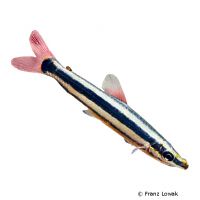Ternetz's Anostomus (Anostomus ternetzi)
| Ternetz's Anostomus Anostomus ternetzi | |
|---|---|
| Name | Ternetz's Anostomus |
| Name Lat. | Anostomus ternetzi |
| Family | Headstanders |
| Family lat. | Anostomidae |
| Order | Characins |
| Order lat. | Characiformes |
| Origin | South America |
| Habitat | Rivers, streams |
| Diet | Omnivore |
| pH | 5.5-7.5 |
| Behavior | Semi-aggressive |
| Keeping | Individual, group |
| Care Level | Moderate |
| Reproduction | Egg scatterer |
| Breeding | None reported |
| Life Span | 3-5 years |
| Protection | No |
| Metric Units | |
| Size | 12 cm |
| Temperature | 24-28 °C |
| Hardness | 1-15 °dH |
| Aquarium | 120 cm / 240 l |
| US Units | |
| Size | 4.7" |
| Temperature | 75-82 °F |
| Hardness | 18-267 ppm |
| Aquarium | 65 gal |
Distribution and habitat
The distribution range of the golden-striped headstander is river systems in the Amazon, Araguaia and Orinoco basins, as well as coastal rivers in Guyana. They mainly stay in the flowing waters of shallow rivers and streams between rock crevices with abundant algae growth.
Maintenance
The aquarium should have dense planting, with large-leaved plants as well as floating plants, and many hiding places from stones (e.g. crevices, niches, caves) and roots. A dark substrate with some foliage (e.g. sea almond or oak leaves), clear water and a weak current are ideal.
No ammonia, ammonium or nitrite should be detectable, the nitrate value should not exceed 100 mg/l. To ensure the water quality and oxygen content, a filter and heater adapted to the aquarium size is required, as well as lighting for the species-appropriate day-night rhythm of the animals.
Diet
They eat the vegetable cover (growth) of stones, wood, plants, etc. and the microorganisms contained therein. The food supply consists of zucchini and avocado pieces, peas, algae leaves and spinach, as well as high-quality dry food (flakes, granules and tablets) with high vegetable content. In addition, some live food, such as cyclops, daphnia and artemia, which is also accepted in frozen form, and commercially available frozen special food mixtures.
Regular and varied feeding promotes health and prevents deficiency symptoms. Only as much should be fed as is eaten immediately (in a maximum of 10 minutes).
Behaviour and compatibility
A group of at least 5 golden-striped cobblers should be kept together, but more is better. In groups that are too small, they occasionally become weakly territorial within the species. They can be socialized well with other peaceful fish.
Basically, only compatible fish species with similar demands on water condition and water temperature should be socialized.
Sex dimorphism
No definite distinguishing characteristics are known. The females appear somewhat larger and more plump.
Reproduction and breeding
There are no known reports of successful breeding in the aquarium.
Important
They are good jumpers, so the aquarium should be well covered.
The well-being of the fish should be checked regularly. The temperature should be checked daily, the pH, hardness and nitrate value at least every 14 days. Regular partial water changes are recommended, even if the contaminant level has not yet reached the upper limit. Sudden changes in water quality should be avoided. Newly introduced fish must be accustomed slowly to the water in the aquarium.
Further literature can be found in your pet store.
References
Text: Werner Winter; Image: Franz Lowak
Source: BMELV (1998): Tierschutzgutachten - Haltung von Zierfischen (Süßwasser); RIEHL & BAENSCH (2006): Aquarien Atlas Bd. 1, Mergus Verlag; ENGELMANN (2005): Zootierhaltung - Tiere in menschlicher Obhut: Fische, Verlag Harri Deutsch
- Gemäß § 21 Abs. 5 Tierschutzgesetz idgF
